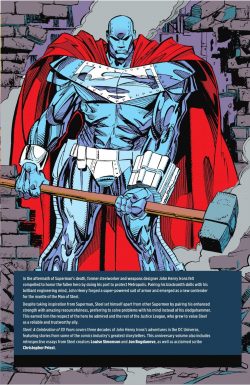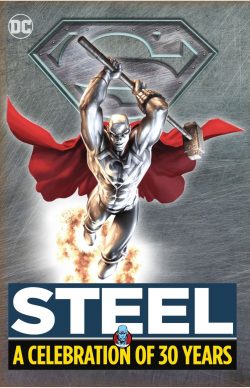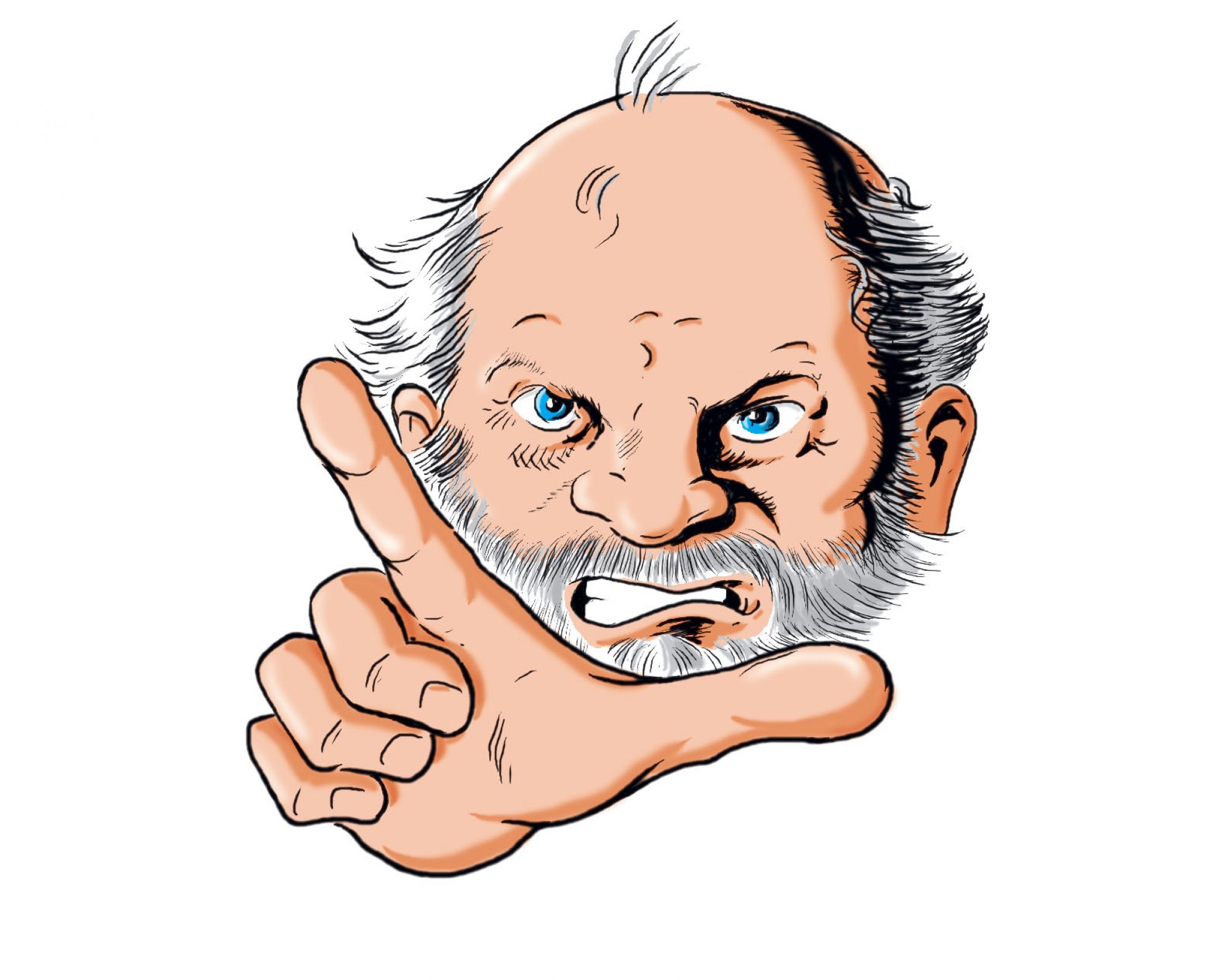

By Louise Simonson, Jon Bogdanove, Christopher Priest, Grant Morrison, Mark Schultz, Mateo Casali, Steve Lyons, Scholly Fisch, Matt Kindt, Chris Batista, Denys Cowan, Arnie Jorgensen, Doug Mahnke, Darryl Banks, Scott Cohn, Ed Benes, Rags Morales, Brad Walker, Patrick Zircher, June Brigman & various (DC Comics)
ISBN: 978-1-7795-2173-6 (HB/Digital edition)
All superhero sagas seek to forge fresh legends and mythologies for and around their protagonists and antagonists. A select few (like Thor, Wonder Woman, Hercules, Fables or Robin Hood) can shortcut the process by borrowing from already established communal story traditions. Steel always leaned into the latter: adapting and reiterating the folklore of actual historical personage John Henry: a 19th century African American Freedman known as the “steel-driving man” who worked building railroads and died proving human superiority and tenacity over technological innovation.
This epic compilation – part of a dedicated series reintroducing and exploiting the comics pedigree of DC icons – offers snapshots of a modern black Thomas Edison (or more accurately Tony Stark) who is equal parts impassioned justice seeker, dynamic defender and modern Hephaestus. Through groundbreaking appearances as part of the Superman Family, and standing on his own two jet-booted feet in the ever expanding DCU, it features material from Adventures of Superman #500, Superman: The Man of Steel #22, 100, 122, Steel (volume 1) #1, 34, JLA #17, Justice League Unlimited #35, Steel (volume 2) #1, Action Comics #4, Suicide Squad #24, and The Death of Superman 30th Anniversary Special #1, and like all these curated collections offers introductory essays preceding time-themed selections. We open with Part I: 1993-1998 – The Forging of a Hero by Steel co-creator Louise Simonson prior to her, Jon Bogdanove & Dennis Janke’s tantalising teaser ‘First Sighting’ as seen in Adventures of Superman #500. In the aftermath of catastrophe a new threat imperils the streets of Metropolis and a battered but mighty figure stirs from the rubble muttering “Doomsday”…
Steel’s story began with landmark publishing event The Death of Superman: a 3-pronged story-arc depicting the martyrdom, loss, replacement and resurrection of the World’s Greatest Superhero in a stellar saga which broke all records and proved that a jaded general public still cared about the venerable, veteran icon of Truth, Justice and the American Way. After a brutal rampage across Middle America, a mysterious marauding monster had only been stopped in the heart of Metropolis by an overwhelming and fatal effort on Superman’s part. Dying at the scene, the fallen hero’s body was subject of many legal battles before it was ostensibly laid to rest in a tomb in Metropolis’ Centennial Park. As Earth adjusted to a World Without a Superman, rumours began to circulate that, like Elvis, the Man of Tomorrow was not dead. The aforementioned ‘First Sightings’ revealed how across America four very different individuals appearing, saving lives and performing good deeds as only the departed defender could…
In Superman: The Man of Steel #22 (July 1993), Simonson, Bogdanove, Chris Batista & Rich Faber introduced construction worker Henry Johnson – who had been saved by Superman in the past – who felt compelled to carry on the hero’s mission. After witnessing first-hand street kids murdered by super weapons in the hands of “gangbangers” he built a high-tech suit of armour to facilitate his crusade as. Whilst outraged urban inventor attended disasters and began cleaning up the streets of Metropolis as ‘Steel’, he relentlessly searched for those who used deadly new “toastmasters”: a weapon Irons had designed in another life…
Tracking the munitions enabled him to save the life of a fortune-teller and brought him into savage conflict with White Rabbit – a new criminal major player in the city challenging the secret control of Lex Luthor – but his life only got more complicated the morning after, when Psychic Rosie went on TV claiming Steel was possessed by the unquiet soul of Superman…
To see how that situation was resolved check out Reign of The Supermen collections but here – following the defeat of the Cyborg-Superman – our ironclad iconoclast underwent a partial refit in Steel (volume 1) #1, as writers Simonson & Bogdanove and artists Batista & Rich Fabee ‘Wrought Iron’ with Johnson resuming his previous identity as John Henry Irons and returning to his hometown and family in Washington D.C. ready to settle the problems he had originally fled from.
Welcomed back by niece Natasha, he and she are almost killed in another gang war and toastmaster crossfire, so John Henry begins a sustained and convoluted campaign against his former corporate employers Amertek, White Rabbit and the lying SOBs who allowed his junked superweapons program (AKA the BG60) to be sold to criminals. His first task is to upgrade and reforge his briefly retired armoured identity…
After an epic career as a reluctant superhero, John Henry and Natasha relocate to Jersey City as Christopher Priest, Denys Cowan & Tom Palmer reboot proceedings. In ‘Bang’ he reinvents himself as a maker of medical hardware and prosthetics working for a barely disguised supervillain. With all concerned leaning heavily into the perceived notion of Steel as a second-rate substitute, Priest consequently crafted one of the funniest and most thrilling superhero series of the decade and one long overdue to be featured in its own collection.
Steel was becoming increasingly popular and was rewarded with membership in the new sensation-series – the reconstituted Justice League. Here in his April 1998 induction from JLA #17, Grant Morrison, Arnie Jorgensen, David Meikis & Marl Pennington show ‘Prometheus Unbound’ as the ambitious neophyte supervillain attacks the entire League in their moon base Watchtower. As recent recruits Huntress, Plastic Man, fallen angel Zauriel and covert information resource Oracle join the regular team invite the world’s press to their lunar base, this unwise courtesy inadvertently allows the insidious seemingly unstoppable mastermind to infiltrate and almost destroy them.
The heroes – despite initially succumbing to Prometheus’ blitz-attack – strike back, aided by unlikely surprise guest-star Catwoman and the last-minute appearance of New Gods Orion and Big Barda proffering yet more hints of the greater threat to come. Although playing a significant part in the win, Steel is not really a star here but at least proves he can play well with the big dogs…
Priest then provides fascinating insight to his take on Dr. Irons and his tenure’s overt concentration of racism and comedy in an essay segueing neatly into Part II: 2000-2011 – Forging the Future prior to adventures in a new millennium.
In Superman: The Man of Steel #100 (May 2000), Mark Schultz, Doug Mahnke & Tom Nguyen offer a ‘Creation Story’ as John Henry and Natasha set up shop in Metropolis with their (she’s a SuperGenius too and ultimately also became an mecha-outfitted superhero) “Steelworks” facility, helping Superman reconstruct his Fortress of Solitude from recovered Kryptonian and Phantom Zone raw materials. The artificers are unaware that an old enemy is sending new menace Luna and her Cybermoths to plunder their achievements…
Despite their always being the best of friends, Superman: The Man of Steel #122 (March 2002) notionally succumbs to the inevitable in Superman v Steel’ by Schultz, Darryl Banks & Kevin Conrad as Irons battles crippling anxieties after accepting a potential trojan horse weapon – the Entropy Aegis – from Darkseid and using it as the basis of new armour. With monsters trying to reclaim it and Superman begging him not to use it, frayed tempers snap…
As well as an ill-received – and unjustly derided – cinema iteration (really! – check it out with more forgiving modern eyes), Steel made the jump to television numerous times. The best was his tenure in the Cartoon Network Justice League/Justice League Unlimited animated shows and the comic books they spawned. Next up here is Mateo Casali, Scott Cohn & Al Nickerson’s all-ages romp ‘The Cycle’ (Justice League Unlimited #35, September 2007), with John Henry and Natasha in the Watchtower before leading the team against reawakened elder gods The Millennium Giants…
Having grown overlarge and unwieldy once more, DC took a draconian leap as its continuity was again pruned and repatterned. In October 2011, publishing event Flashpoint led to a “New 52”: radical yet mostly cosmetic changes that barely affected the properties reimagined. Just before that kicked off, John Henry got a stirring “hail and farewell” in Steel (volume 2, 2011) #1. ‘Reign of Doomsday, Part 1: Full Circle’ by Steve (Doctor Who) Lyons & Ed Benes opened a Superman Family mass-crossover as the marauding monster returned to crush all S-Sheild superstars, starting with John Henry before moving on to The Outsiders and others…
Concluding chapter Part III: 2012-Present – The First Black Superman opens with a treatise and career appraisal of “DC’s Iron Man” by Bogdanove, after which the techno-warrior is reimagined by Morrison, Rags Morales, Rick Bryant & Sean Parsons in Action Comics (volume 2) #4, January 2012. ‘Superman and the Men of Steel’ sees a young Man of Tomorrow starting out as a vigilante, pursued by Military Consultant Lex Luthor and losing to the latter’s Kryptonite fuelled cyborg Metallo until a technologist working on the Steel Soldier program dons the armour he’s building to save the embattled young hero…
From the same issue, ‘Hearts of Steel’ – by Scholly Fisch, Brad Walker & Jay David Ramos – concludes the 3-way war and provides insight into the valiant newcomer, before Suicide Squad #24 (volume 4, December 2013) taps into publishing event Forever Evil with ‘Excuse the Mess…’ by Matt Kindt, Patrick Zircher & Jason Keith. As Earth is infiltrated by invaders from an alternate reality, conscripts of Amanda Waller’s penal unit (Thinker, King Shark, Captain Boomerang, Deadshot and Harley Quinn) rebel when the world’s supervillain community unites to crush the heroes. Opposing the rebellion and fighting to keep a living WMD from them are an Unknown Soldier, vigilante Warrant, Power Girl and Steel…
In 2015, as the New 52 experiment staggered to a conclusion, a series of company-wide events offered speculative glimpses at what might have been. Following 2014’s Futures End came Convergence in April 2015: a series of character-derived micro-series referencing key periods in the amalgamated history of DC heroes. Crafted by Simonson, June Brigman, Roy Richardson & John Rauch, Convergence: Superman: Man of Steel #1-2 depicted ‘Divided We Fall’ & ‘United We Stand’ as assorted cities from varied publishing epochs of continuity are imprisoned under domes by Telos, slave of Brainiac and ordered to fight each other until only one survives. Referencing their 1990s iteration, Irons, Natasha and nephew Jemahl armour up beside maniacal villain The Parasite to battle the abrasive superteens of Gen 13…
We end by turning full circle as Louise Simonson, Jon Bogdanove & colourist Glenn Whitmore share undisclosed secrets from the first appearance of Steel, as finally revealed in The Death of Superman 30th Anniversary Special #1 (November 2022).‘Time’ expands on ‘First Sightings’, taking readers back to the moments Doomsday ripped through Metropolis and showing how “Henry Johnson” saved lives as he ran towards the life or death battle to aid Superman however he can…
With covers by Bogdanove & Janke, Dave Johnson, Howard Porter & John Dell, Doug Mahnke & Tom Nguyen, John Cassaday & Richard Horie, Zach Howard, Alex Garner, Morales & Brad Anderson, Steve Skroce & Jason Keith, Walter Simonson & Dave McCaig, these tales span cover-dates January 1993 to November 2022; a period where black heroes finally became acceptable comics currency – at least for most people – and this too brief collation of groundbreaking yarns only begs the question: why isn’t more of this wonderful stuff already available?
© 1993, 1994, 1997, 1998, 2000, 2002, 2007, 2011, 2012, 2013, 2015, 2022, 2023 DC Comics. All Rights Reserved.
